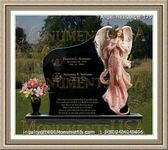|
Facts To Know When Concerning Memorial Plaques
When someone passes away, those left behind must begin the process of healing. There are many ways in which people deal with the grief of loss. One method used to help with this challenge is to have cemetery plaques installed on the deceased's final resting place.
The feeling of disbelief at the loss is often set aside once the marker is in place. These items provide the first bit of closure by creating a solid reminder that someone has passed as well as providing a memorial that may be visited whenever comfort is needed. For many people, both of these things are extremely important to begin accepting the reality and coping with their grief.
A monument of this type will forever let others know that a person worth remember once lived. The name of the one buried within the plot is emblazoned on the plaque, usually accompanied by their birth and death dates. Some people find it comforting to also add an epitaph, decorative designs or engravings.
A fair variety of styles, shapes and sizes are available in this choice of marker. Many of them are flush for easy mounting, though it is not uncommon to see them with the features either added in dimensional relief or carved into the material. Personal preferences are generally what determines just how simple or complex the design will be.
Several different materials can be used for their construction. The most popular choice is bronze because of its durable properties, easy casting and beautiful appearance. Other substances such as stainless steel, brass, slate, granite and marble are also commonly used for this purpose.
While the wishes of the deceased or their surviving family members are important, there might be other factors to be considered when choosing a design. Some burial facilities may place restrictions on what styles and materials may be used. The climate could also affect the choices that are viable in a particular region.
|
|



























